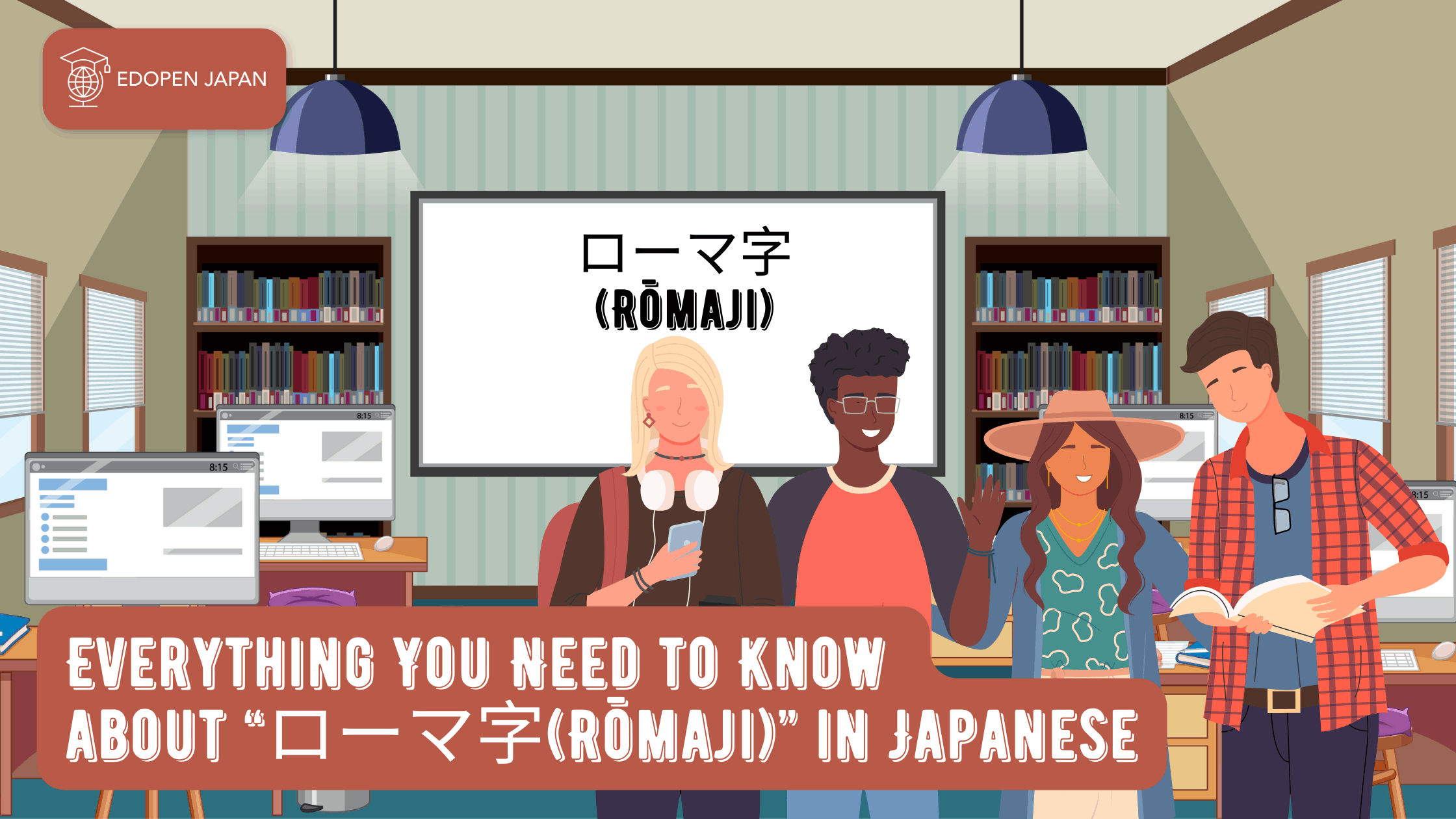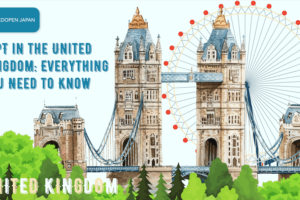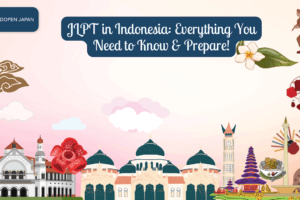Have you ever seen Rōmaji? If you are in Japan, you can see “Rōmaji” everywhere, such as train stations and traffic. If you are ready to take the plunge and finally start your Japanese learning journey, you may be thinking, what is “Rōmaji”? Also, do you really need to learn hiragana, katakana, and kanji?
Don’t we already see Japanese transliterated into English with words like sayonara and sushi? Surely you can cut your language learning time in half by just learning to read Japanese using the English alphabet. Let’s learn great tips about “Romaji” and the Japanese writing system!
In addition, if you are also interested in studying the Japanese language and culture in more depth, please also read our recommended reading below, just for you!
Read also:
10 Simple & Easy Steps to Learn Japanese for Beginners
How to Learn Japanese Speaking? 10 Simple Steps
How to Learn Japanese Fast: 10 Smart Methods
Contents
What does “Romaji” actually mean?
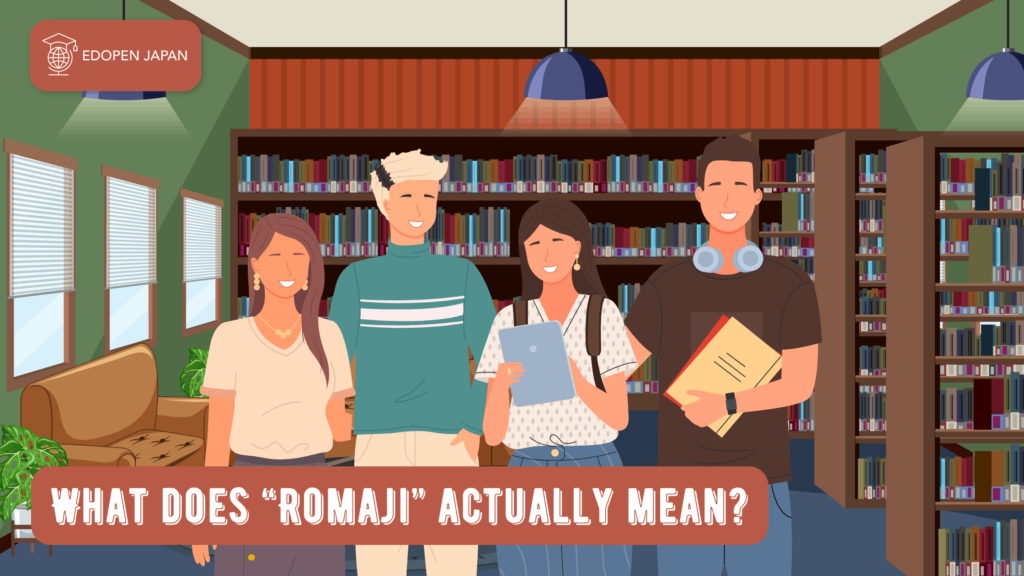
For a variety of reasons, “Rōmaji” is used throughout Japan. You’ll notice that most train stations in Japan use “Rōmaji” to translate the station name into English. Road signs in Japan often do the same. “Romaji” or “ローマ字 (Rōmaji)” is the romanization of the written Japanese language. “Romaji” is the method of writing Japanese words using the Roman alphabet.
Since the Japanese writing system is a combination of “Kanji” and “Kana” scripts, “Romaji” is used to make Japanese text understandable to non-Japanese speakers who cannot read “Kanji” or “Kana” scripts. This is commonly used in Japan for street directions, passports, dictionaries, or textbooks for learning Japanese.
Do Japanese people use “Romaji”?
Many people who have learned Japanese may wonder, “Do Japanese people even use “Romaji”? The answer to this question is yes! Japanese people, like those who can read “Kanji” or “Kana” station names, are exposed to and can read “Romaji” in their daily lives.
Many Japanese students learn “Romaji” in elementary school so that they can write their own names in English. This makes it easy for children to know how to introduce themselves to strangers.
Japanese students learn “Romaji” in elementary school to spell their names with English letters, making it easier for them to fit into the international environment. You may also see “Romaji” interspersed throughout an article, advertisement, or graphic design.
In addition, most Web sites require the use of English letters in usernames and passwords, most programming languages are in English, and touch typing on a QWERTY keyboard is arguably faster than using a Kana keyboard. In the 21st century, there’s no getting around the dominance of English and its influence on information technology.
“ローマ字 (Rōmaji)” and the Japanese language
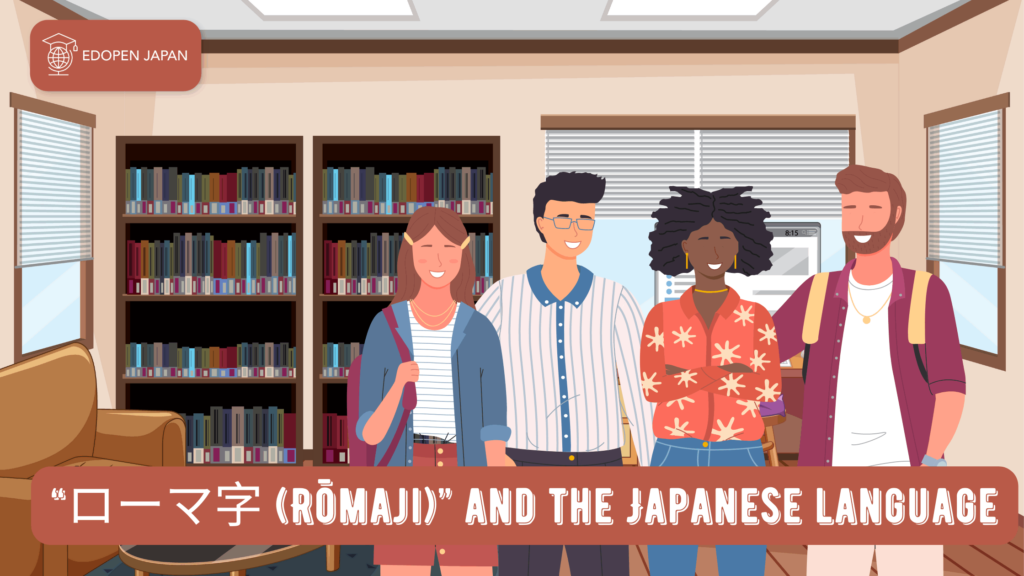
In order to understand Romaji, it is best to first understand the Japanese language and how it is written. Japanese is a member of the Japanese family of languages. The Japanese language is written in three scripts: “Kanji”, “Hiragana”, and “Katakana” (漢字、ひらがな、かたかな).
“Kanji” refers to the Chinese characters that have been introduced into Japan from neighboring China over the course of its history. “Hiragana” and “Katakana” are also syllabic scripts that can be spoken as they are written.
History of “Romaji”
Japan is known for its centuries-long policy of isolation, from 1639 to the Meiji period, during which the country closed its borders to almost all foreign trade and cultural imports. However, in the century before this isolationist period, Japan had regular trade with European countries such as the Netherlands and Portugal. It was Jesuit missionaries from Portugal who first introduced the Roman alphabet to the Japanese in the mid-16th century.
In addition, a Japanese Catholic named Yajiro developed the “Romaji” writing system in 1548, which was soon printed by Jesuit missionaries. “Romaji became less popular during the isolationist period, but made a comeback as Japan shed its isolationist policies and worked to become a global player in the Meiji period.
All Japanese who have attended elementary school since World War II have been taught to read and write romanized Japanese. Therefore, almost all Japanese can read and write Japanese using “romaji”, although it is extremely rare to use this method of writing Japanese in Japan, and most Japanese are more comfortable reading “kanji” and “kana”.
Three Types of “Romaji”
Basically, “romanization” is the transliteration of Japanese terms into Roman characters or other languages that use the Roman alphabet. There are several romanization systems for the Japanese language. The three main systems are “Hepburn,” “Nihon-shiki,” and “Kunrei-shiki.
| 1. ヘボン式 (Hebon-shiki): The widely known Hepburn system |
| 2. 日本式 (Nihon-shiki): Nihon-shiki system |
| 3. 訓令式 (Kunrei-shiki): Kunrei-shiki system |
This table compares the three romanization systems. As you can see, the same Japanese word can be spelled in up to three different ways! “Hepburn” is one of the three main systems. The “Hepburn” method is the most popular and widely used. The “Hepburn” system does a better job of reflecting pronunciation in its transliteration of Japanese syllables.
For example:
(た, ち, つ, て, and と) are written as (ta, chi, tsu, te, and to).
Syllable pairs such as (しゃ and じゃ) are written as (sha and ja).
Meanwhile, in the “Nihon-shiki” system and “Kunrei-shiki” system, you will see 【た, ち, つ, て, and と 】 written as 【ta, ti, tu, te, and to】. The syllable pair 【しゃ】 is written as 【sya】 and【じゃ】 is 【zya】. However, in Kunrei-shiki, 【ず】 and 【づ】 are romanized the same way as 【zu】, while in Nihon-shiki they are differentiated (【ず】 is 【zu】 and 【づ】 is 【du】).
| Kunrei-shiki (訓令式) | Hepburn system (ヘボン式) |
| ta ti tu te to | ta chi tsu te to |
| da di du de do | da ji zu de do |
| za zi zu ze zo | za ji zu ze zo |
| sya syu syo | sha shu sho |
Hepburn-shiki (ヘボン式)
The overall goal and purpose of the Hepburn system is to teach non-Japanese how to read and pronounce Japanese. As mentioned above, the Portuguese Jesuits were the first Europeans to attempt to romanize the Japanese language.
For this reason, the Hepburn system has a pronunciation system similar to that of Italian, Spanish, and Portuguese. Specifically, the consonants of this system are the same as those of English, but the vowels are those of Italian, Spanish, and Portuguese.
Hepburn is the most popular system because it is popular outside of Japan. It is the system used in Japanese textbooks for students learning Japanese, and the system historically used by the Portuguese to transcribe the Japanese language.
It is also the system used to romanize the titles of anime, manga, and Japanese games. Hepburn is the most popular system, but not everyone in Japan knows or understands Hepburn, so it’s a good idea to brush up on the other two.
日本式 (Nihon-Shiki or The Romaji on the street)
The “Nihon-shiki” system is used by Japanese people when they need to write in the Latin alphabet. Since the way Japanese and foreigners romanize their own scripts is different, two different romanization systems are used.
When Japanese people need to create user names, enter URLs for Web sites, or write their names in the Latin alphabet, they usually use it online and on their mobile phones. The name of this system literally translates to “Japanese writing”.
Unlike the Hepburn method, this approach comes naturally to native Japanese speakers and makes perfect sense if you know and speak the language. The system was invented by physicist Aikitsu Tanakadate (田中館 愛橘) in 1885 to replace the Hepburn romanization system.
訓令式 (Kunrei-shiki)
“Kunrei-Shiki” means “style of teaching” in Japanese. Except for a few spelling variations, Kunrei-Shiki is almost identical to Nihon-Shiki. As a result, this approach is also intended for native Japanese speakers. After World War II, the system was created to modernize the “Nihon-Shiki” system, and it was adopted in 1937 while the Japanese government was debating whether to adopt the “Nihon-Shiki” or the Hepburn system.
In other words, the system simply made “Nihon-shiki” more up-to-date as the Japanese language changed. “Kunrei-Shiki” also takes inspiration from the Hepburn system, and it romanizes the Japanese particles はをへ as wa, e, and o, just as the Hepburn system does. “Kunrei-Shiki” is the romanization system used by most of today’s Japanese youth. It’s the most up-to-date method of romanization for native Japanese speakers.
For a better understanding, please refer to the following comparison table!
| English | Japanese | Hepburn | Nihon-shiki | Kunrei-shiki |
| Romanization | ローマ字 | Rōmaji | Rômazi | Rômazi |
| Mt. Fuji | 富士山(ふじさん) | Fujisan | Huzisan | Huzisan |
| Japanese Tea | お茶 | Ocha | Otya | Otya |
| Governer | 知事(ちじ) | Chiji | Chizi | Chizi |
| To shrink | 縮む(ちぢむ) | Chijimu | Chizimu | Chidimu |
| To continue | 続く(つづく) | Tsuzuku | Tuzuku | Tuduku |
The main difference between the three systems is that the “Hepburn system” makes more use of sounds that are common in Western languages. “Kunrei and Nihon system” may be confusing to an English speaker, but will make perfect sense to a native Japanese speaker.
The Comparison of Good & Bad Aspects of Romaji
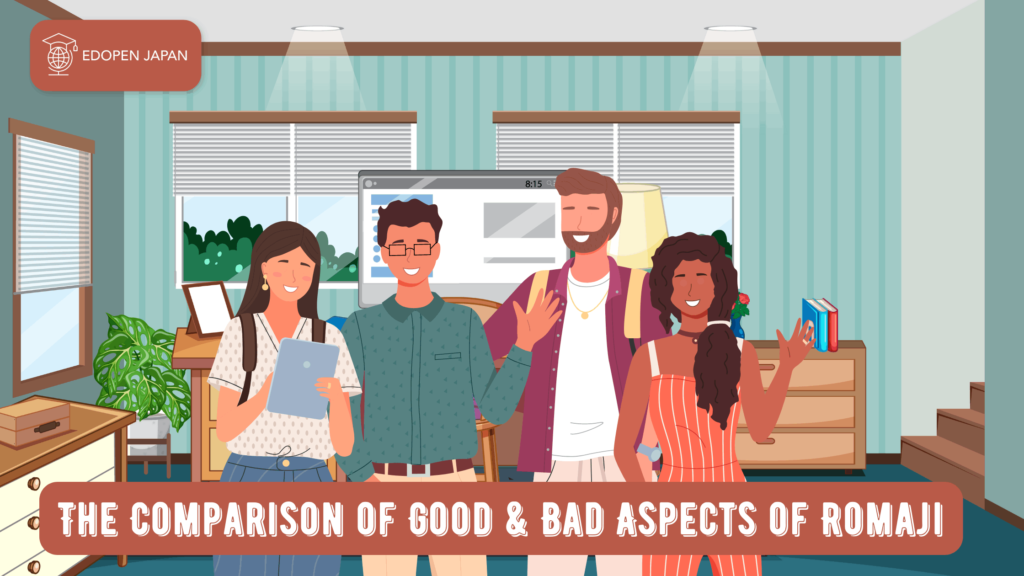
What is the good aspect of Romaji?
The best thing about “Romaji” is that a beginner can read a word or phrase and mostly understand the pronunciation. It may be discouraging for some who want to learn some vocabulary and phrases, but haven’t yet gotten a handle on hiragana and katana, if all their resources are without “Romaji”.
And if you haven’t gotten used to using a Japanese keyboard yet, typing your search terms in “romaji” is the most efficient way to find what you’re looking for! In fact, there are two types of keyboard input you can choose from: “Kana” input (かな入力) or “Romaji” input (ローマ字入力).
What is the bad aspect of “Romaji”?
Romaji will mostly help you understand how to pronounce, but there are times when it can be misleading.
- Romaji could lead to wrong pronunciation.
There is simply no “du” sound in Japanese. Also, “ず” is pronounced “zu,” but “づ” sounds much more like “dzu” when pronounced. If you read a text after learning Kana, it’s easier to recognize “づ” and pronounce it correctly. - Bad pronunciation habits may result from Romaji.
There are Japanese words that we often encounter in English, such as “Tokyo,” “Sayonara,” and “Arigato. You may have experienced some initial surprise when you learned that “Tokyo” (とうきょう) is pronounced with two long syllables “Toukyou” and not three short syllables “To-ki-o”.
“Sayonara” (さようなら) does not have the emphasis on the “na” syllable often heard in English, but rather a long, drawn-out “you” sound “Sa-you-nara”. This is another flaw of Romaji. The system’s inconsistent styles often lead people into bad pronunciation habits.
There are Japanese words that we often encounter in English, such as “Tokyo,” “Sayonara,” and “Arigato. You may have experienced some initial surprise when you learned that “Tokyo” (とうきょう) is pronounced with two long syllables “Toukyou” and not three short syllables “To-ki-o”. “Sayonara” (さようなら) does not have the emphasis on the “na” syllable often heard in English, but rather a long, drawn-out “you” sound “Sa-you-nara”. This is another flaw of Romaji. The system’s inconsistent styles often lead people into bad pronunciation habits. - Romaji can be difficult to read and understand.
The other big problem is going beyond words to reading whole sentences or paragraphs in Romaji.
Comparison examples for using romanization, hiragana, katakana, and kanji
Next, please take a look at the following example of how to introduce yourself, first written entirely in Romaji:
Hajimemashite.
Watashi no namae wa Will Sumisu desu.
Daigaku ninensei desu.
Nihongo no benkyou wo ganbatteimasu.
Yoroshiku onegaishimasu.
That’s a lot of letters and very hard to read! Compare it to the same sentences written entirely in “Kana”. Then, let’s go to the next pattern using Hiragana dan Katakana only.
はじめまして。
わたしのなまえはウィル・スミスです。
だいがくにねんせいです。
にほんごのべんきょうをがんばっています。
よろしくおねがいします。
Using Hiragana and Katakana above somehow it’s a little easier to get through. That’s because kana represent syllables, or more specifically rhythmic units called “mora,” so the sounds “h” and “a” are combined to form a unit. Next, please see examples of the use of hiragana, katakana, and kanji in 1 Japanese sentence that are in common use today.
はじめまして。
私の名前はウィル・スミスです。
大学二年生です。
日本語の勉強を頑張っています。
よろしくおねがいします。
Meaning:
Nice to meet you.
My name is Andrew Smith.
I’m a sophomore.
I’m currently working hard to learn Japanese.
Please take good care of me!
Once you can start incorporating kanji into your language learning, reading becomes much easier.
The Final Thought
The point is that “Romaji” is a great first step in learning the Japanese language, but try not to rely on it for too long. As you begin to memorize words and grammar points, “Romaji” will eventually slow you down and hinder your reading speed and comprehension. First, “Romaji” should be treated as a “writing system,” not as a way to learn pronunciation.
Using “Romaji” as a preparatory step to learning “Kana” and “Kanji” will help you learn Japanese, but when you feel like you have a good foundation in “Kana”, you can drop the “Romaji”. When you step out of your comfort zone and learn “Hiragana” and “Katakana”, the sense of pride and accomplishment you will feel when you can read Japanese words in “Kana” and “Kanji” is great.
There’s nothing quite like that bubbling feeling of empowerment and excitement once you’ve mastered the Japanese writing system and hope this will help your Japanese learning journey.
Summary
Let’s go over the important points of the discussion of the material on “ローマ字(Rōmaji)” together this time as follows:
- “Romaji” is the method of writing Japanese words using the Roman alphabet. Since the Japanese writing system is a combination of “Kanji” and “Kana” scripts, “Romaji” is used for understanding by non-Japanese speakers who cannot read “Kanji” or “Kana” scripts.
- In Japan, “Romaji” is used in every everyday situation, so Japanese students learn “Romaji” in elementary school.
- There are several romanization systems for the Japanese language. The three main systems are “Hepburn,” “Nihon-shiki,” and “Kunrei-shiki. And “Hepburn” is the most popular and widely used around the world.
- The Portuguese Jesuits were the first Europeans to attempt to Romanize the Japanese language, so the “Hepburn” system has a pronunciation system similar to the other languages.
- “Romaji” is a great first step in learning the Japanese language, but you should not rely heavily on “Romaji” to read or speak Japanese in order to develop learning “Kana” and “Kanji”.
What do you think? Are there any points missing? Stay passionate about learning Japanese language and culture with us. Thank you to those of you who have read to the end. We truly appreciate your kindness. See you in another article!

